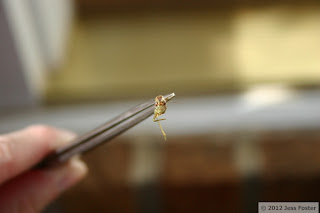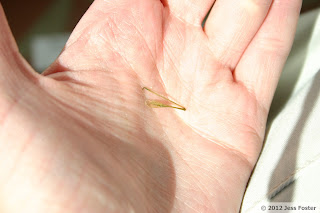So, having established that my specimen was a katydid and not a grasshopper, I just had to figure out what species it was. After further research, I narrowed it down to a member of the subfamily Conocephalinae, which, as the name implies, includes katydids with heads that taper into a cone. Then, judging by appearance, as there are different types of "cone-heads," I settled on the tribe Conocephalini: meadow katydids. I believe the genus is Conocephalus: lesser meadow katydids. And the species? Probably fasciatus, though I'm not certain. There are also two subspecies, but I don't know how to determine if it's one of those.
Therefore I believe my specimen is of the species Conocephalus fasciatus, or Slender Meadow Katydids. If I've identified it incorrectly, please let me know. Below are the photos of at least one specimen, though there could very well be three in all.
A katydid on a Phlox plant:
 |
| See how long those antennae are? |
 |
| From this angle you can see the rounded top of the katydid's head: the "cone." |
A katydid on the glass of our storm door:
 |
| One of its antennae has been shortened. |
Check out Thysse's site for more info: http://bugs.adrianthysse.com/2011/01/ento-101-external-structure-i-intro-and-integument/.
A dead katydid, with little of its body left uneaten:
 |
| Its entire abdomen is gone, plus most of the thorax, for those areas, containing vital organs and tissues, have the most value for a predator. |
 |
| The dark stripe characteristic of the living specimens I showed above is visible on this one's head. Its antennae have been significantly shortened. |
 |
| A frontal view. |
 |
| The thorax has been hollowed out, but its protective covering, the pronotum, remains. |
 |
| A hind leg. |
 |
| I took this photo after I moved its leg a bit; the joint still worked! Unfortunately it didn't work for long, and the leg broke. |
http://www.entnemdept.ufl.edu/walker/buzz/231a.htm (slender meadow katydids)
http://bugguide.net/node/view/23962 (slender meadow katydids)
http://bugguide.net/node/view/164 (katydids)













No comments:
Post a Comment